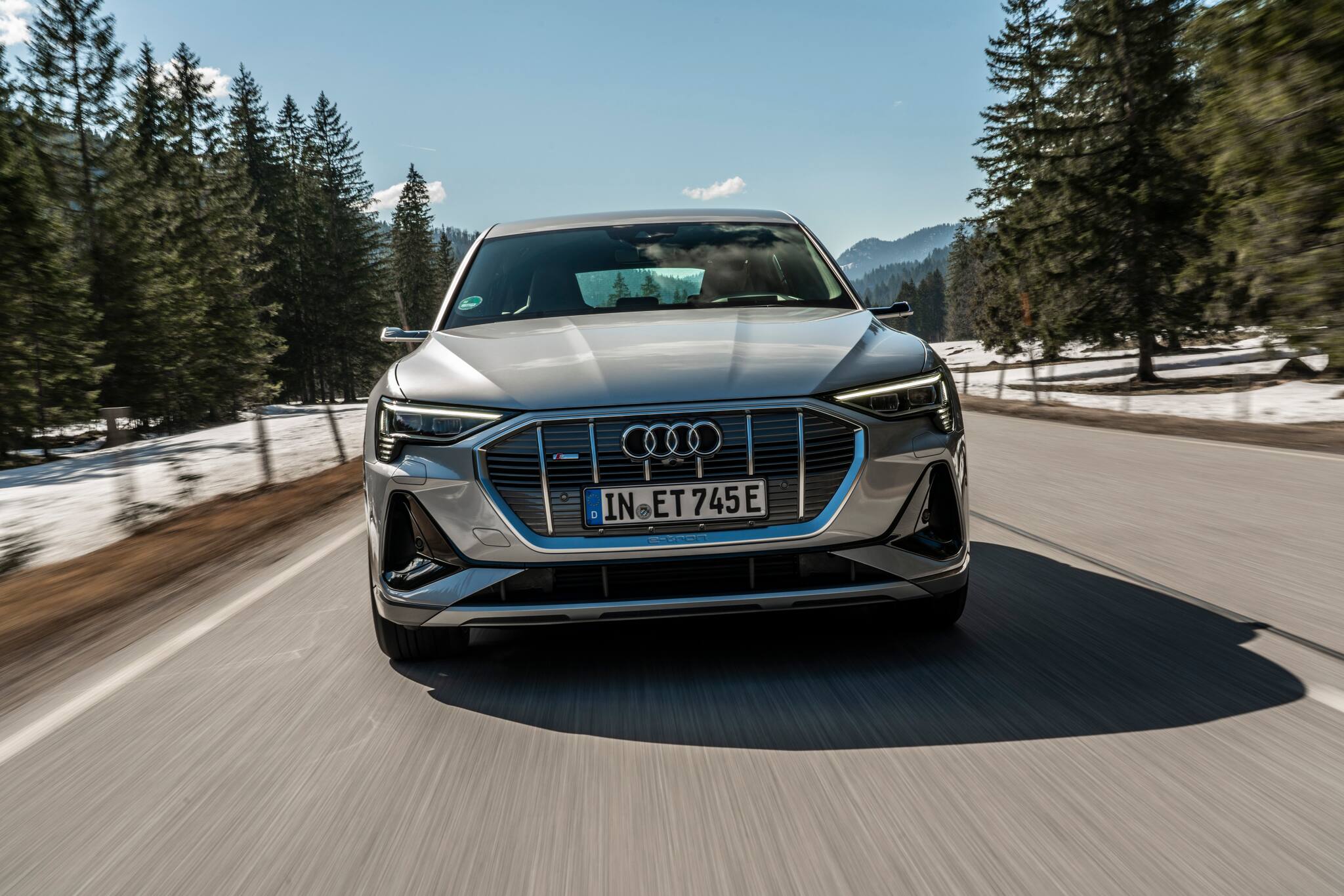



Okay, so the Audi e-tron 55 Sportback is big. I’d forgotten about its sheer road presence in the months that have elapsed since I drove its square-backed counterpart but something about the Sportback’s plunging roofline just does it for me. It doesn’t just look good for the sake of looking good, mind you. This is one of the most aerodynamically efficient series-productions SUVs out there and when it comes to EVs, that tends to have an immediate effect on the range. If this is what the future of cars looks (and sounds) like, sign me up.
As you may have surmised by now, the only major difference between the e-tron 55 Quattro and the e-tron 55 Sportback lies in the silhouette. While the 55 Quattro is more conventionally styled, similar to the Q8, the Sportback features a coupe-like roofline. Both cars were launched simultaneously last year along with a “50” badged variant featuring a smaller battery. The trio, along with the e-tron GT and RS e-tron GT announced Audi’s EV supremacy across the luxury car landscape in India. Both the Sportback and the Quattro have gone on to bag several awards this year and with good reason.
 Audi has been wise to take the relatively conventional approach while designing its EVs.
Audi has been wise to take the relatively conventional approach while designing its EVs.
Powertrain is identical to the standard e-tron with two asynchronous motors joining forces to produce 408hp of power from a sizable 95 kWh battery (offering a real-world range of about 370 km). Torque levels are staggering at 664Nm, vectored and delivered by an even more intuitive e-Quattro system, which means grip is always available no matter how much you push the Sportback. Its comparatively lower ride height than the 55 Quattro (which can be modulated electronically) makes it marginally more dynamic, but truth be told, with a 95kWh battery at the base of the car, both e-tron variants offer better grip than any mechanical-Quattro equipped Audi. It’s no RS-powered car, and the steering continues to feel characteristically light, but it's a Herculean task to unsettle the e-tron Sportback on any kind of surface and cornering stability is top-notch.
And then there’s its brute acceleration. It’s an uncanny feeling not having to work a gearbox to prime the engine for a turbo-assisted explosion of torque. With the e-tron it comes in instantaneously, whenever you want it. You’d think it's a party trick you can tire of easily but it isn’t. What makes it more eerie is the nonchalant manner in which it is deployed. Other than the artificial, Starship Enterprise-like electronic hum, there’s really no aural cue to the e-tron’s ascent to triple digits. Slot the e-tron into “S” mode and you’re propelled via a boost function utilising every horsepower at the car’s disposal. In “D” you get a more controlled input of power.
Yes, all EVs are quiet. But none in my experience so far, including the formidable Jaguar i-Pace, block out ambient noise as effectively as the e-tron 55 Quattro and Sportback. The e-tron takes a bat and practically bludgeons every surrounding decibel in the vicinity. Stepping out of the car you almost feel overwhelmed with aural stimuli, so well insulated is the e-tron Sportback’s cabin. Buffeting winds and road noise are all theoretical concepts when you’re seated inside.
If you’re wondering what the paddles behind the steering are for, it’s essentially a way to increase the potency of the regenerative braking system. Press the left paddle towards you while braking and you can increase the level of intervention from the regenerative braking system, helping bring this 2.6-tonne behemoth to a halt. If there’s one thing in the EV-driving learning curve that takes getting used to is recalibrating your braking inputs. Because once this thing gathers momentum, you can feel the weight hurtling forward, upon hard braking.
Audi has been wise to take the relatively conventional approach while designing its EVs. Particularly when it comes to the interiors since the giant-tablet infested cabin of a Tesla can feel a tad alienating to customers who wish to make a more gradual shift to EVs. But where the Audi truly towers over the likes of new-age EV makers, is in its ability to provide the sort of cabin insularity and material quality that’s among the best in the world. Yes, the absence of physical buttons for temperature management etc. continues to be bothersome and I hope Audi eventually comes around to letting us do what evolution has designed us to – use opposable thumbs to modulate rotary buttons instead of jabbing our digits into a sterile touchscreen. The dual touchscreen display does give it that futuristic edge, but the key thing working in Audi’s favour is its virtual cockpit instrument display.
Despite riding on 20-inch wheels, the e-tron’s adaptive air suspension does a fine job of absorbing the bumps. Adaptive air suspension might be the niftiest feature on an otherwise exhaustive list of features that includes matrix LEDs, wireless phone charging as standard while soft-close doors and a 360-degree camera remain optional extras. Party foul, Audi. Also, the absence of wireless Apple CarPlay in a car so advanced (and expensive) truly baffles the mind.
Verdict
At Rs 1.18 crore (ex-showroom) the e-tron Sportback is merely Rs 2 lakh more than the standard 55 Quattro which means there isn’t a pronounced price difference, especially if you’re besotted by its rakish good looks. As a stand-alone EV, there’s little to fault here. The e-tron Sportback is a fine example of the advantage legacy carmakers continue to have when it comes to impeccable build quality and drivetrain refinement. Silicon Valley may have the edge in terms of software and battery optimisation, but the simple fact is that the e-tron (Sportback or otherwise) is the best electric SUV I’ve driven thus far. It swishes and swooshes its way into your consciousness with its quietude, balanced ride quality and performance. It’s novel and yet it feels traditionally fortified. It’s zero-emission luxury at its finest.
 Despite riding on 20-inch wheels, the e-tron’s adaptive air suspension does a fine job of absorbing the bumps.
Despite riding on 20-inch wheels, the e-tron’s adaptive air suspension does a fine job of absorbing the bumps.
Pro: Styling, performance, build quality, familiar interiors, insular cabin
Cons: Loss of rear headroom by 20mm and boot space by roughly 45 litres.
Discover the latest Business News, Sensex, and Nifty updates. Obtain Personal Finance insights, tax queries, and expert opinions on Moneycontrol or download the Moneycontrol App to stay updated!
Find the best of Al News in one place, specially curated for you every weekend.
Stay on top of the latest tech trends and biggest startup news.